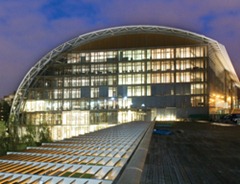European Investment Bank profile
 Despite the European Investment Bank’s relatively low profile, it has had a major tangible impact in Ireland since the State joined the EU. Peter Cheney explains its role.
Despite the European Investment Bank’s relatively low profile, it has had a major tangible impact in Ireland since the State joined the EU. Peter Cheney explains its role.
Most commentary on the continent’s banking centres on the European Central Bank, established in 1998 to serve the euro zone members (now with 17 members) and based in Frankfurt. The European Investment Bank (EIB) in Luxembourg, by comparison, dates back to 1957 and is the bank for the whole EU, owned by all 27 member states.
EU finance ministers make up the board of governors, while the board of directors approves loans. Michael Somers, the former Chief Executive of the National Treasury Management Agency, is an alternate Director for Ireland. The current EIB President, Werner Hoyer, was appointed in December 2011 and was previously a Minister of State in the German Foreign Office.
The EIB characterises its work as “lending, blending and advising”. Lending mainly covers loan finance (typically over 4-20 years) and also guarantees, micro-finance and equity investment. ‘Blending’ is the unlocking of finance from other sources, principally the EU budget. Clients are also advised on administrative and project management capacity, to enable delivery on investments.
Bond issues are the main source of revenue and its current credit ratings are AAA (Fitch and Standard and Poor’s) and Aaa (Moody). The bank generally finances one-third of project costs, and not more than 50 per cent, and aims to achieve a multiplier effect, attracting additional funds from the public and private sectors.
Subscribed capital stood at €232.4 billion on 31 December 2011. In that year, €60.9 billion of loans were signed off: 88.2 per cent within the EU and the reminder to neighbouring or developing countries.
In total, the EIB has signed contracts worth €11.8 billion in Ireland. Investments between 2006 and 2010 totalled €2.63 billion: 44 per cent for energy and 35 per cent for transport. EirGrid’s East-West Interconnector received the single largest investment (€300 million), followed by Dublin Airport’s Terminal 2 (€260 million).
€360 million was made available for SME loans through the Allied Irish Bank, Bank of Ireland, Ulster Bank and Bank of Scotland (Ireland).
Another €831 million has been signed off since 2010, including this year’s single investment of €100 million, to modernise or construct 47 schools by December 2014. However, that compares to total investments of €398 million in Cyprus and €288 million in Hungary so far this year, reflecting greater infrastructure needs.
Two Irish proposals are currently being assessed: €200 million for SMEs and midcap investment loans via Allied Irish Banks and €200 million for Irish Water’s investment programme.
In line with other multi-lateral banks, its 1,950 staff includes an in-house ‘corps’ of 300 engineers and economists who assess proposals against strict economic, technical, environmental and social standards.
The bank is both non-profit and policy-driven, with six priorities for 2011-2013: economic and social cohesion and convergence; implementing the knowledge economy; developing trans-European networks; protecting and improving the environment and promoting sustainable communities; supporting SMEs; and supporting sustainable, competitive and secure energy.
Variable rate loans are usually available in a spread below the Libor rate. The EIB is also the majority shareholder (62 per cent) in the €3 billion European Investment Fund, set up in 1994 to provide venture capital and guarantees to SMEs. In June, EU leaders approved a €10 billion increase in the bank’s capital limits to help boost growth. This will increase its lending capacity by €60 billion over three or four years.





